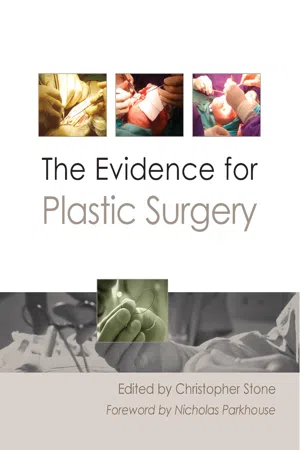
- English
- ePUB (mobile friendly)
- Available on iOS & Android
The Evidence for Plastic Surgery
About This Book
Evidence-based medicine is now firmly established in the lexicon of modern health care. In The Evidence for Plastic Surgery the diverse spectrum of plastic surgical practice is called to account by a cross-examination of the available evidence in support of many of the common treatment protocols and surgical procedures in everyday use. The result is a text that makes an important contribution to some of the contentious debates within the specialty and details the critical appraisal of new or developing techniques. The Evidence for Plastic Surgery is a unique and invaluable reference source for senior doctors and for those in training, not only in plastic surgery but also in a variety of other closely aligned specialties including general and orthopaedic surgery.
Frequently asked questions
Information
Chapter 1
Timing and method of soft tissue reconstruction in patients with IIIb tibial fractures
Introduction
Methodology
Classification of open fractures
| Table 1. Gustilo’s revised classification of open fractures 15. | |
| Type I | Open fracture |
| Clean wound <1cm in length | |
| Type II | Open fracture |
| Laceration >1cm long without extensive soft tissue damage, flaps or avulsions | |
| Type III | Open fracture |
| Extensive soft tissue laceration, damage or loss | |
| Open segmental fracture or traumatic amputation | |
| High velocity gunshot injuries | |
| Open fractures caused by farm injuries | |
| Open fractures requiring vascular repair | |
| Open fractures older than 8 hours | |
| Type III subtype (1984) | |
| A | Adequate periosteal cover of a fractured bone despite extensive soft tissue laceration or damage High energy trauma irrespective of size of wound |
| B | Extensive soft tissue loss with periosteal stripping and bone exposure Usually associated with massive contamination |
| C | Associated with arterial injury requiring repair |
Epidemiology
Table of contents
- Cover Page
- Title Page
- Publisher
- Contents
- Foreword
- Introduction: Applying evidence-based medicine to plastic surgery
- Chapter 1: Timing and method of soft tissue reconstruction in patients with IIIb tibial fractures
- Chapter 2: Vacuum-assisted closure: basic science and clinical practice
- Chapter 3: The management of necrotising fasciitis
- Chapter 4: The relationship between increasing body mass index and complications in plastic surgery
- Chapter 5: Prophylaxis to prevent venous thrombo-embolic disease in plastic surgery patients
- Chapter 6: Physiological responses to burn injury and resuscitation protocols for adult major burns
- Chapter 7: Improving outcome in paediatric burns
- Chapter 8: Biological skin substitutes
- Chapter 9: Sentinel lymph node biopsy in melanoma
- Chapter 10: Management of inguinal and pelvic nodes in patients with stage III malignant melanoma
- Chapter 11: Prognostic indicators in adult soft tissue sarcoma
- Chapter 12: Evidence-based imaging of soft tissue sarcomas
- Chapter 13: Hypospadias correction: one or two stages?
- Chapter 14: Cleft palate closure: the timing and options for surgical repair
- Chapter 15: Post-traumatic wrist instability
- Chapter 16: Wrist arthroscopy: its role in diagnosis and treatment
- Chapter 17: The role of small joint arthroplasty in osteoarthritis of the hand
- Chapter 18: Monitoring of microvascular free tissue transfers
- Chapter 19: Use of the anterolateral thigh flap for intra-oral reconstruction
- Chapter 20: A comparison of TRAM and DIEP flaps for breast reconstruction
- Chapter 21: Immediate versus delayed breast reconstruction
- Chapter 22: Strategies for minimising palpable implant rippling in the augmented breast
- Chapter 23: Gynaecomastia: an algorithmic approach to surgical management (with special emphasis on liposuction)
- Chapter 24: Trends in aesthetic facial surgery: the role of endoscopic brow and minimal access facial lifts
- Chapter 25: Surgical rejuvenation of the aging neck
- Chapter 26: Trends in aesthetic facial surgery: the Hamra lower lid blepharoplasty
- Chapter 27: Fibrin sealant in plastic surgery
- Chapter 28: Ablative and non-ablative techniques for rejuvenation of photo-aged skin
- Chapter 29: Hand and facial composite tissue allotransplantation
- Chapter 30: Hyperbaric oxygen therapy in plastic surgery